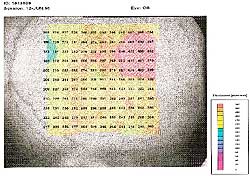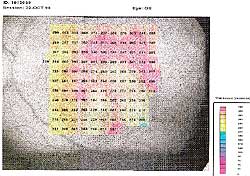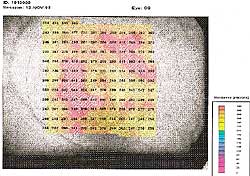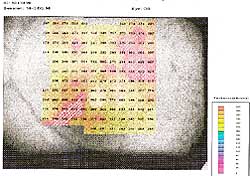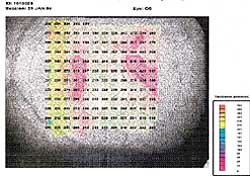Retinal thickness analyzer provides high reproducibility and helps determine surgery
Diabetic macular edema can be detected at an early stage using this non-contact approach.
NEW YORK — A computerized retinal thickness analyzer from Talia Technology Ltd. has proven to be effective for diagnosing macular edema in diabetics, for monitoring and for planning surgery with laser treatment.
“I believe this analyzer provides a very reprodu cible, quantitative method of documenting changes in macular edema, specifically in diabetics. The way we diagnose treatable macular edema in diabetics is based on our interpretation of areas of retinal thickening related to the macula,” said Richard B. Rosen, MD, program director of the ophthalmology department at the New York Eye and Ear Infirmary and associate professor of clinical ophthalmology at New York Medical College.
With other current techniques, a contact-lens examination is performed each time a patient visits the office. “The contact lens is somewhat invasive. In contrast, the retinal thickness analyzer is a non-contact approach,” said Dr. Rosen, who has been using the device clinically for about 3 years. “It allows us to monitor these patients in a relatively painless way. We can monitor as these patients progressively worsen and decide at what point we need to treat them. We can also monitor the response to treatment to see if patients improve. Be cause the device is computerized, there is a lot of reproducibility already built in. The analyzer becomes very standardized between ob servers,” Dr. Rosen said.
Laser slit lamp
The stand-alone, noninvasive instrument is essentially a computerized slit lamp for the retina. “It works as a laser slit lamp. The alignment screen permits the operator to see a live slit image along with a fundus image, as well as the positioning points for what area of the retina is being scanned,” Dr. Rosen said. The area scan shows 10 slits covering 2 mm by 2 mm. The thickness map generated is from about 200 line scans.
The printed report includes maps and statistical values. “The color is basically a range of thickness. This allows the doctor to see instantly the areas that are thick versus those areas that have more normal thickness. Doctors can then hone in on more precise information within the report. There is cross-sectional information which shows limits of normal on either side of the subject you are looking at,” Dr. Rosen said.
Clinical results indicate an ability “to pick up areas of thickening that you might not be able to detect on a normal exam,” Dr. Rosen said. The analyzer provides a third-dimensional aspect to the fundus examination in a quantitative format. This includes cases of inflammation or vascular decompensation that produce retinal thickening.
The analyzer also allows one to review the results of photocoagulation treatment “very precisely, and to determine if our treatment targeted the correct areas. With photocoagulation, it is important to minimize the amount of treatment to minimize injury to the visually sensitive areas of the retina. Therefore, you want to basically target the areas of greatest thickening,” Dr. Rosen said
The glaucoma application for the retinal thickness analyzer is not as well developed as for diabetics, although there have been some reports that the device appears to be a very reliable indicator of nerve fiber layer thinning.
Two peaks
The principle of operation for the retinal thickness analyzer is a slit beam that generates two peaks as it interfaces with the retina, one at the internal limiting membrane and the other at the retinal pigment epithelium. “The computer then identifies these two peaks and measures the difference between them. This figure is used as the basis for calculating thickness,” Dr. Rosen said
When comparing the analyzer to optical coherence tomography (OCT), there are both advantages and disadvantages. “The analyzer provides a large map of the macular in one image. The OCT generates single images of cross-sections. With diabetics, though, you are more interested in looking at a large map,” Dr. Rosen said. The OCT’s interferometric signal is a reconstructed image, but “if you have a specific lesion in one area, the OCT scan is sometimes more helpful.”
The green light of the analyzer also does not penetrate as deeply as the OCT’s infrared light, so “the green light tends to be absorbed more superficially at the level of the retina,” Dr. Rosen said. “The infrared does not have the theoretical level of resolution because it is a longer wavelength. But from a practical standpoint, I’m not sure there is really that much difference in resolution. The retinal thickness analyzer has a level of sensitivity which is much greater than most trained clinical observers.”
Dr. Rosen believes the retinal thickness analyzer is ideal for busy practices that treat a lot of patients with diabetes. “You can carefully document and monitor a course of macular disease in diabetics, especially in the early stages,” he said. The device, which costs about $60,000, can be operated by a technician or photographer.
|
| |
|
|
|
|
For Your Information:
- Richard B. Rosen, MD, can be reached at New York Eye and Ear Infirmary, 310 E. 14th St., New York, NY 10003 U.S.A.; +(1) 212-979-4288; fax: +(1) 212-979-4268. Dr. Rosen has no direct financial interest in the products mentioned in this article, nor is he a paid consultant for any companies mentioned.
- Talia Technology Ltd. can be reached at D.N. Harei Yehuda, 90850 Israel; +(972) 253-440-23 ext. 6; Fax: +(972) 253-444-86.

